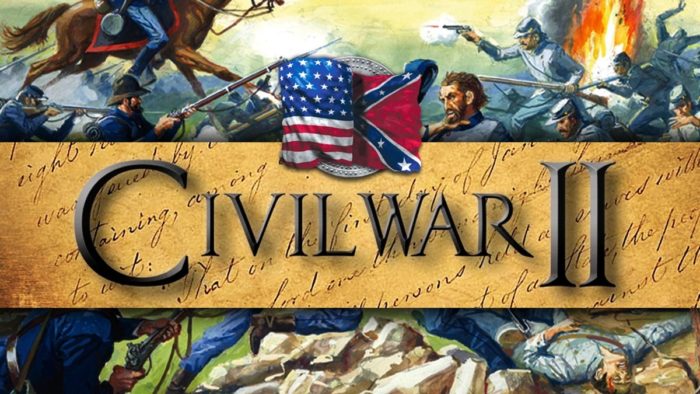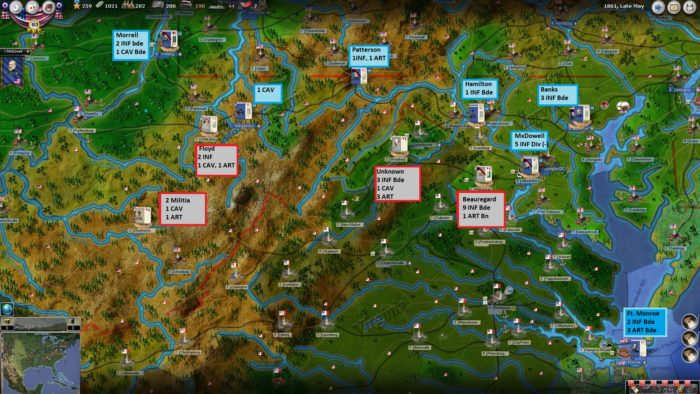Civil War II – An After Action Report! Part 2
In the excellent book “How the North Won”, Herman Hattaway and Archer Jones describe the first months of the war as “the two sides steadily grop[ing] towards military preparedness.” That is an apt description of the first few months of my game (April-May 1861). At the start, there are few Union military units and almost all are fixed at various garrisons throughout the US, making military operations impossible. Further, there are no generals to lead them. Lacking both manpower and generals, my initial moves are limited to beginning to build the Union military. However, the economy of the Union is not geared for supporting the rapid buildup of the military. In particular, building naval units requires large amounts of war supplies. The current Union production of war supplies effectively limits naval expansion to only one naval blockade flotilla a turn, along with a few brigades of infantry and possibly a unit of artillery.
By: Tripoli,
April 1861 (Turns 1-2)
Strategic Overview
National Moral: 85 (Defeat at 40)
Victory Points: 50
Foreign Intervention: 2
CSA Mil. Power: 37% of US Army
11% of US Navy
Economic Overview
Cash: $200,000
Militia: 50
War Supplies: 60
Rail Transportation Points: 150
River Transportation Points: 30
To begin mobilizing the Union economy onto a war footing, I raise taxes, increasing revenue by $800,000 and lowering prices by 1%, but with a 2 point hit to my national morale. I could have raised the same amount of money by issuing bonds, but I didn’t want to lose 25 victory points that decision would cost. Additional telegraph lines are also ordered, producing additional economic growth and a few victory points at a small cost. These VP will offset the loss of VP from my taxing and blockade decisions.
The only political decision I make is to order an immediate blockade. This costs $50,000, one morale and 15 VP, and with unknown effects towards European intervention.
The Confederacy offers trade concessions to the European powers, in order to improve relations with them. Although partially successful, its effects are mitigated to a degree by my declaration of a blockade, which created some trepidation in London and Paris on the wisdom of intervention. The net result is that the foreign intervention score increases to 10. The CSA also begins to print money, providing them with necessary cash, albeit with a 4% inflation rate to the South’s economy.
Aside from the fall of Ft. Sumter and the secession of Virginia, the other noteworthy event of April is some rioting in Baltimore, resulting in the destruction of rail lines through the city. Apparently, giving “those who wished to destroy space to do that” has a long history in Baltimore.[1] Unfortunately for the virtual rioters in my game, the severing of a major rail line from the industries of New England to Washington is something I can’t tolerate. I suspend the writ of Habeas Corpus in Baltimore and send additional troops there to put the city under martial law. Hopefully, this will improve the low (25%) level of public support for the Union cause in that city.
May 1861 (Turns 3-4)
Strategic Overview
National Moral: 85 (Defeat at 40)
Victory Point: 184
Foreign Intervention: 6
CSA Mil. Power: 53% of US Army
12% of US Navy
Economic Overview
Cash: $1,336,000
Militia: 281
War Supplies: 312
Rail Transport Points: 193
River Transport Points: 44
Weather
Eastern Theater: Mud in WV, MD
Western Theater: Mud in TN
Trans-Mississippi: Clear
Blockade
Atlantic, Gulf of Mexico distant blockade is 25% effective
Major Events
- Political: Tennessee, North Carolina and Arkansas secede
- CSA declares a cotton embargo, increasing the odds of foreign intervention
- The popular support for the US in Baltimore & St. Louis decreases to only 25%.
- McDowell and the Northeast Virginia Army aka Army of the Potomac appears in Alexandria, VA
The continued unenlightened attitude of the citizens of Baltimore and St. Louis toward the Union cause is dangerous, as both cities are vital to the Union effort. A revolt in Baltimore could isolate Washington DC and a revolt in St. Louis could cut the Mississippi River LOC. The garrisons in both cities should be able to hold them, but to make sure I declare martial law in Baltimore and suspend the writ of habeas corpus in St. Louis. That should improve the morale of the rabble….
Builds
The sudden jump of the CSA military from 37% to 53% of Union land power is concerning. Apparently, early in the war the CSA mobilizes more efficiently than the Union. I will have to increase the size of my army more quickly to maintain the superiority I need for my operations in 1861. One blockade squadron, 5 infantry brigades, 1 cavalry brigades and 3 artillery battalions are ordered. Two thirds of these will go the western theater. In late May, another blockading squadron is ordered, along with some headquarters support, medical support troops and naval engineers. These support troops will make my army headquarters and various construction activities more efficient.
Military
The Army of the Potomac under McDowell (3-5-2) appears in Alexandria. (note: the stats for leaders are given as strategic/offense/defense. The leader stats in this game are heavily randomized, so a bad leader in real life may be a good leader in the game. The strategic rating is the most important, as it determines whether a leader will move and receive combat bonuses). The five understrength divisions of the army are fixed, so there are no offensive operations I can engage in the eastern theater. However, its generals will need to be replaced. Currently, the army looks like this:
- 1st Div (D. Tyler 1-4-1)
- 2nd Div (D. Hunter 1-2-1)
- 3rd Div (S. Heintzelman 4-1-2)
- 4th Div(T. Runion 4-2-1)
- 5th Div (D. Miles 1-4-1)
Most of the Union combat leadership have minimal ratings, and are largely suited only for non-offensive operations. I also have a pool of available generals that appeared in Washington:
Hamilton 0-4-4
Milroy 4-2-2
Morell 4-3-1
McCall 3-1-1
Hurlbert 3-2-4
Wood 5-4-1
Blenker 6-1-3
Asboth 0-4-1
Griffin 0-1-1
Humphries 2-1-3
Howe 6-1-1
Keys 1-1-1
L.Wallace 6-2-1
Shields 4-2-4
Some of these generals will end up being sent to the Western Theater to command the units I’m building along the Kentucky border. Lew Wallace will go to St. Louis to help evict the CSA out of Missouri. Blenker and Wood will take over units of the Army of the Potomac and Howe will increase McDowell’s strategy rating by becoming his aide de camp. Those with particularly low stats, like Asboth and Griffin, will be sent to Pittsburg where they can’t do any harm.
General Lyons (3-3-3) appears in St. Louis with a brigade of infantry. However, the Union forces here are also fixed, so there is little change in my dispositions. Plus, I will need these Union troops to try to pacify the city.
[1] https://baltimore.cbslocal.com/2015/04/25/baltimore-mayor-gave-those-who-wished-to-destroy-space-to-do-that/
In late May I notice that Norfolk, VA appears to be unoccupied. Although I lack any transports, I begin to gather a small force in Baltimore for a possible attempt to reoccupy Norfolk. If I can hold the city, it would provide a third Avenue of Approach (AOA) towards Richmond, complicating the CSA’s defensive problem in the Eastern Theater. I also move a small blocking force under Hamilton opposite Harper’s Ferry to discourage a Confederate advance from there into Maryland.
Stay tuned for Part 3!
Chat about it below, or in our forums, or hit our FaceBook page >>




